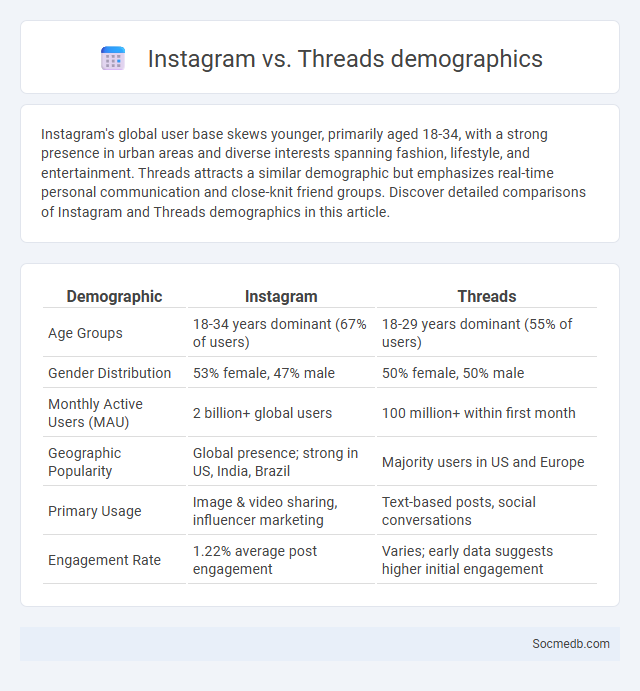
Photo illustration: Instagram vs Threads demographics
Instagram's global user base skews younger, primarily aged 18-34, with a strong presence in urban areas and diverse interests spanning fashion, lifestyle, and entertainment. Threads attracts a similar demographic but emphasizes real-time personal communication and close-knit friend groups. Discover detailed comparisons of Instagram and Threads demographics in this article.
Table of Comparison
| Demographic | Threads | |
|---|---|---|
| Age Groups | 18-34 years dominant (67% of users) | 18-29 years dominant (55% of users) |
| Gender Distribution | 53% female, 47% male | 50% female, 50% male |
| Monthly Active Users (MAU) | 2 billion+ global users | 100 million+ within first month |
| Geographic Popularity | Global presence; strong in US, India, Brazil | Majority users in US and Europe |
| Primary Usage | Image & video sharing, influencer marketing | Text-based posts, social conversations |
| Engagement Rate | 1.22% average post engagement | Varies; early data suggests higher initial engagement |
Overview of Instagram and Threads: Platform Demographics
Instagram attracts over 2 billion monthly active users globally, with a strong presence among 18 to 34-year-olds, making it a dominant platform for visual content and influencer marketing. Threads, launched by Meta as a companion to Instagram, targets the same demographic but focuses on real-time, text-based conversations, aiming to rival Twitter with a growing user base concentrated in North America and Europe. Both platforms emphasize engagement, with Instagram excelling in photo and video sharing and Threads fostering community interaction through short-form discussions.
Age Distribution: Instagram vs Threads Users
Instagram's age distribution skews towards younger users, with 67% of 18-29-year-olds active on the platform compared to 47% on Threads, which is rapidly growing its Gen Z and Millennial base. Despite Instagram's established presence, Threads appeals more to users aged 18-34, capturing a significant portion of your target audience interested in real-time, text-based interactions. Marketers should leverage Threads' emerging popularity among younger demographics to complement Instagram's broader yet slightly older user base for maximum engagement.
Gender Representation: Comparing User Bases
Social media platforms display varying gender representation, with studies showing that women tend to dominate platforms like Instagram and Pinterest, while men are more prevalent on LinkedIn and Reddit. Understanding these demographic trends helps tailor marketing strategies to engage Your target audience effectively. Analyzing user base gender distribution offers valuable insights for optimizing content and advertising campaigns.
Geographic Location: Where Instagram and Threads Thrive
Instagram and Threads thrive predominantly in urban centers across North America, Europe, and Asia, with cities like New York, London, and Tokyo showcasing the highest user engagement rates. These platforms benefit from dense populations and advanced digital infrastructures, facilitating real-time sharing and interaction. Emerging markets in Southeast Asia and Latin America also exhibit rapid growth, driven by expanding smartphone penetration and younger demographics.
Socioeconomic Status of Users
Social media platforms exhibit diverse user engagement patterns influenced by socioeconomic status, with higher-income groups often accessing premium features and exhibiting distinct consumption behaviors. Users from lower socioeconomic backgrounds tend to rely on mobile devices for access, affecting interaction types and content preferences. Analyzing these disparities informs targeted marketing strategies and digital inclusion policies.
Education Level: Platform Preferences
Your social media platform preferences vary significantly based on education level, with college graduates favoring LinkedIn and Twitter for professional networking and information sharing. High school graduates tend to prefer visually-oriented platforms like Instagram and TikTok for entertainment and social interaction. Understanding these trends helps tailor content strategies to engage specific educational demographics effectively.
Interests and Content Engagement Patterns
Social media users exhibit diverse interests ranging from entertainment, fashion, and technology to health and politics, which significantly influence their content engagement patterns. High engagement rates are often seen with visually appealing posts, interactive content, and personalized recommendations tailored to individual preferences. Understanding these patterns helps optimize content strategies by targeting specific audience segments and enhancing user interaction metrics.
Influencer and Creator Demographics
Influencer and creator demographics reveal a diverse range of age groups, with the majority falling between 18 and 34 years old, reflecting a strong presence of Millennials and Gen Z. Platforms like Instagram, TikTok, and YouTube dominate as preferred channels for content creation, with a significant gender split showing slightly more female influencers. Understanding these demographics helps you tailor marketing strategies to effectively engage target audiences and maximize campaign impact.
Brand and Business Demographics on Both Platforms
Facebook attracts an older demographic with a strong presence among users aged 25-54, making it ideal for brands targeting established consumers and professionals. Instagram's younger audience, primarily aged 18-34, favors brands that emphasize visual content, lifestyle, and influencer collaborations. Both platforms support diverse business objectives, but Facebook excels in detailed targeting for local businesses, while Instagram drives engagement for fashion, beauty, and lifestyle brands.
Shifting Trends: Comparing Demographic Growth Over Time
Social media platforms have experienced significant demographic shifts, with younger generations increasingly favoring visually-driven apps like TikTok and Instagram, while older users show growth on Facebook and LinkedIn. Data indicates a rapid surge in Gen Z engagement over the past five years, contrasting with steady growth among millennials and a slower increase among baby boomers. Understanding these trends helps you tailor your social media strategy to target the most active and relevant audiences effectively.
 socmedb.com
socmedb.com